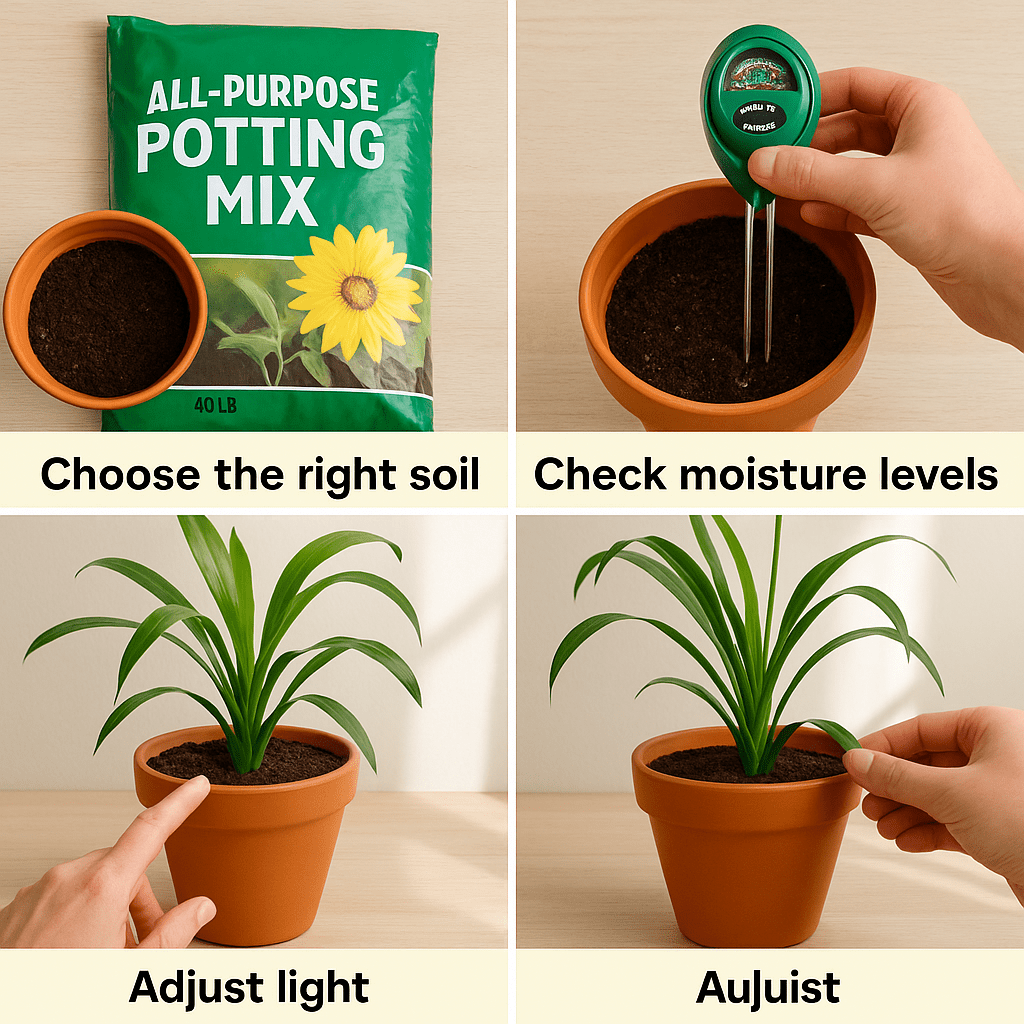If you’re just starting your plant journey, understanding the basics of plant care is essential for success. This guide will walk you through the most important aspects of plant care—lighting, watering, and soil. By the end, you’ll be ready to help your plants thrive, even if you’ve never kept a houseplant alive before.
Understanding the Importance of Lighting
How Light Affects Plant Growth
Light is crucial for photosynthesis, the process by which plants make food. Without the right kind of light, your plant may become leggy, pale, or stop growing altogether.
Types of Light Conditions
- Full Sun: At least 6 hours of direct sunlight daily. Ideal for succulents, herbs, and flowering plants.
- Partial Sun/Shade: 3–6 hours of sunlight. Suitable for leafy greens and some indoor plants.
- Low Light: Indirect or filtered light. Perfect for ferns, snake plants, or ZZ plants.
How to Measure Light at Home
You don’t need a fancy tool to assess lighting. Try these simple methods:
- Shadow Test: Sharp shadows indicate bright light; soft shadows mean medium light; barely visible shadows mean low light.
- Smartphone Light Meter Apps: These can give an approximate reading in lux.
Watering Wisely: The Most Common Mistake
Why Overwatering Is So Harmful
Overwatering leads to root rot, one of the most common causes of plant death. On the flip side, underwatering can cause leaves to curl, drop, or brown at the edges.
General Watering Guidelines
- Check the soil: Insert your finger 1–2 inches deep. If it’s dry, it’s time to water.
- Use room temperature water: Cold water can shock plant roots.
- Drainage is key: Always use pots with holes to avoid soggy soil.
Best Time to Water
Water early in the morning or late afternoon to minimize evaporation and prevent leaf burn.
Choosing the Right Soil
Why Soil Type Matters
Soil isn’t just dirt—it’s the foundation of plant health. The right mix ensures proper drainage, aeration, and nutrient availability.
Basic Soil Categories
- Potting Mix: Great for container plants; typically contains peat, perlite, and compost.
- Cactus/Succulent Mix: Offers excellent drainage; ideal for desert plants.
- Garden Soil: Denser and better for outdoor beds.
DIY Soil Mix for Beginners
Combine:
- 2 parts potting mix
- 1 part perlite or coarse sand
- 1 part compost
This blend works well for a wide range of houseplants and outdoor pots.

Bonus Tips for Thriving Plants
Tip 1: Rotate Your Plants
Rotating your pots weekly ensures even light exposure and balanced growth.
Tip 2: Clean the Leaves
Dust can block light. Gently wipe leaves with a damp cloth every two weeks.
Tip 3: Don’t Rush to Fertilize
Wait at least a month after repotting before applying any fertilizer. For beginners, a diluted liquid fertilizer every 4–6 weeks during the growing season is enough.
Tip 4: Watch for Signs
- Yellow leaves? Could be overwatering.
- Drooping? Might need water or light.
- Brown tips? Check humidity or salt buildup.
If your plant’s leaves are turning yellow, don’t miss our full guide on how to diagnose yellow leaves on houseplants.
Conclusion: You’ve Got This!
Caring for plants doesn’t have to be overwhelming. By focusing on lighting, watering, and soil, you’ll build a strong foundation for healthy growth. Remember, even seasoned gardeners started with one plant and a little curiosity.
Save this guide for your next planting weekend or share it with a friend who’s just starting out!
Frequently Asked Questions (FAQ)
How often should I water my plants?
It depends on the plant and environment. A good rule is to check the top 1–2 inches of soil—if it’s dry, water.
What’s the best plant for beginners?
Snake plants, pothos, and spider plants are excellent choices. They tolerate low light and irregular watering.
Can I use garden soil for indoor plants?
Not recommended. Garden soil can compact in containers and retain too much moisture, leading to root rot.
Looking for a reliable moisture meter to prevent overwatering? Buy one here on Amazon and take better care of your plants.
